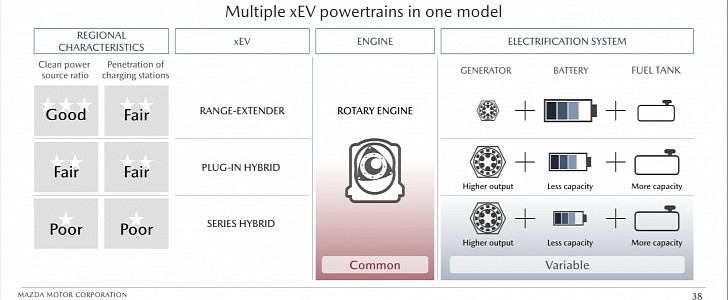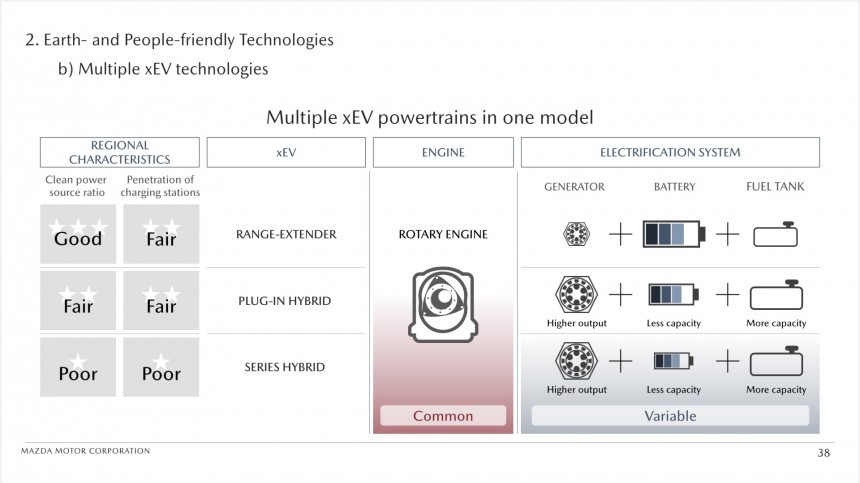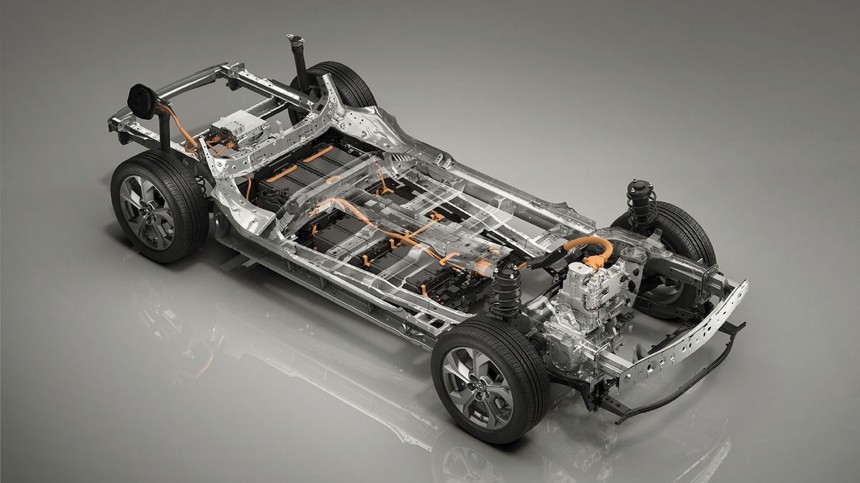If you are following the Mazda story about rotary engines as range extenders for EVs, you must still be confused with what the company seems to have said to Automotive News and Roadshow.
To the first, Mazda confirmed it put those plans on hold. To the second, it said that nothing changed. We managed to talk to Hans Greimel – the Automotive News editor who wrote the article about the plans being halted – and he helped us get this story right. The truth is that everybody was correct.
It may seem impossible that the plans for an electric car with a range extender have been postponed and are unchanged at the same time. Yet, it has to do with two things. The first is the difference between the technical and legal definitions of what a PHEV and an electric car with a range extender are. The second is how Mazda will call its creations.
California’s ZEV (Zero Emission Vehicle) regulation establishes that a “Range Extended Battery Electric Vehicle” or “BEVx” is a vehicle that can run at least “75 all-electric miles” (121 km). Mazda might have recently realized that doing that with the MX-30 would imply making it heavier and more expensive than its version with the rotary engine could be.
Until then, the company was planning to use that mill with three kinds of vehicles: the BEV (battery electric vehicle), the PHEV (plug-in hybrid electric vehicle), and the HEV (hybrid electric vehicle). In all three, the rotary engine would be just a generator, as the image below shows.
To make matters worse, Mazda already sells an HEV version of the MX-30 with a 2.0-liter, four-cylinder engine coupled with a 24V starter generator. That led me to assume that the HEV and PHEV derivatives of the car would be conventional ones in my previous article about this situation, which is definitely not the case.
Long story short, all these Mazda vehicles will be electric, regardless of what you call them: only electric motors will power their wheels. Knowing that is essential to understand the whole story. Even its “HEV” will be electric.
They will follow the same idea that Nissan established with the e-Power system: the electric motor will have just a tiny battery to start moving the vehicle while the engine fires up to give it some electrons. The only difference is that Nissan chose a 1.2-liter three-cylinder mill to charge the batteries; Mazda selected the rotary engine for that task.
When it comes to Mazda’s BEV and the PHEV, the only practical difference between them would be the battery pack capacity. As Greimel mentions in his article, Nikkei said the battery pack for PHEVs usually is around 10 kWh.
If the MX-30 gets a battery pack of this size, it would be equivalent to less than a third of the 35.5 kWh battery pack the pure electric version has. Considering the electric MX-30 offers a range of about 200 km, the 10 kWh component would possibly offer around 70 km (44 mi) of pure electric range in the best-case scenario, far from the 75 mi California demands to call anything a “Range Extended Battery Electric Vehicle.”
Legally speaking, it would have to be defined as a PHEV. To customers, it would still be an electric car with a range extender. Mazda confirmed to autoevolution that “the MX-30 with REx technology is scheduled to arrive in 2022.” It just did not say which battery pack it would present, but it is unlikely that it will have the 35.5 kWh if plans for this version are on hold, as Mazda told Greimel.
That leads us to the bizarre conclusion of this story. In 2022, when Mazda presents the MX-30 with the rotary engine, the U.S. and European press departments will be able to say the plans were unchanged even if the battery pack is smaller. The Japanese PR department may also state that the company is still studying the 35.5 kWh battery pack – which is what all fans of the MX-30 expected in the first place. All of them, Automotive News, and Roadshow will be correct. Weird, right?
To the first, Mazda confirmed it put those plans on hold. To the second, it said that nothing changed. We managed to talk to Hans Greimel – the Automotive News editor who wrote the article about the plans being halted – and he helped us get this story right. The truth is that everybody was correct.
It may seem impossible that the plans for an electric car with a range extender have been postponed and are unchanged at the same time. Yet, it has to do with two things. The first is the difference between the technical and legal definitions of what a PHEV and an electric car with a range extender are. The second is how Mazda will call its creations.
California’s ZEV (Zero Emission Vehicle) regulation establishes that a “Range Extended Battery Electric Vehicle” or “BEVx” is a vehicle that can run at least “75 all-electric miles” (121 km). Mazda might have recently realized that doing that with the MX-30 would imply making it heavier and more expensive than its version with the rotary engine could be.
Until then, the company was planning to use that mill with three kinds of vehicles: the BEV (battery electric vehicle), the PHEV (plug-in hybrid electric vehicle), and the HEV (hybrid electric vehicle). In all three, the rotary engine would be just a generator, as the image below shows.
Long story short, all these Mazda vehicles will be electric, regardless of what you call them: only electric motors will power their wheels. Knowing that is essential to understand the whole story. Even its “HEV” will be electric.
They will follow the same idea that Nissan established with the e-Power system: the electric motor will have just a tiny battery to start moving the vehicle while the engine fires up to give it some electrons. The only difference is that Nissan chose a 1.2-liter three-cylinder mill to charge the batteries; Mazda selected the rotary engine for that task.
If the MX-30 gets a battery pack of this size, it would be equivalent to less than a third of the 35.5 kWh battery pack the pure electric version has. Considering the electric MX-30 offers a range of about 200 km, the 10 kWh component would possibly offer around 70 km (44 mi) of pure electric range in the best-case scenario, far from the 75 mi California demands to call anything a “Range Extended Battery Electric Vehicle.”
Legally speaking, it would have to be defined as a PHEV. To customers, it would still be an electric car with a range extender. Mazda confirmed to autoevolution that “the MX-30 with REx technology is scheduled to arrive in 2022.” It just did not say which battery pack it would present, but it is unlikely that it will have the 35.5 kWh if plans for this version are on hold, as Mazda told Greimel.
That leads us to the bizarre conclusion of this story. In 2022, when Mazda presents the MX-30 with the rotary engine, the U.S. and European press departments will be able to say the plans were unchanged even if the battery pack is smaller. The Japanese PR department may also state that the company is still studying the 35.5 kWh battery pack – which is what all fans of the MX-30 expected in the first place. All of them, Automotive News, and Roadshow will be correct. Weird, right?













